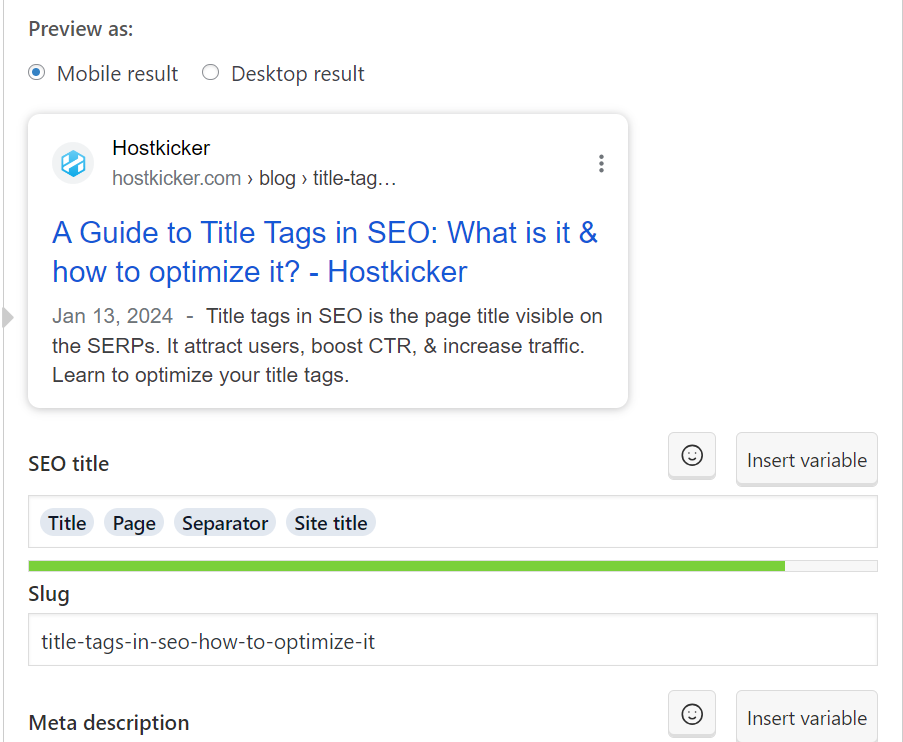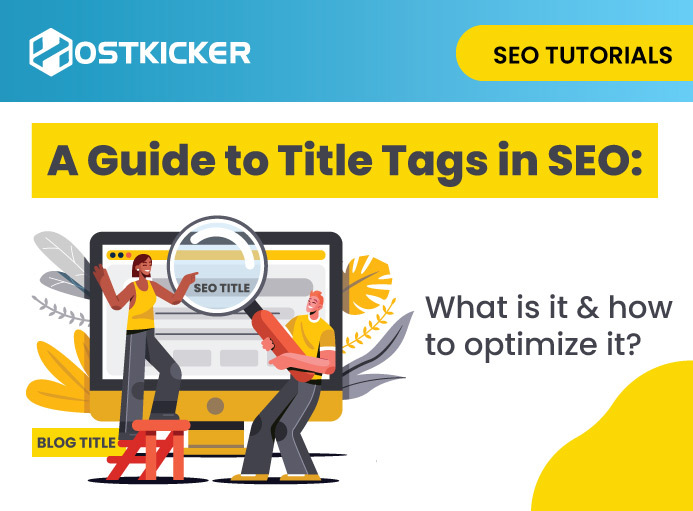A Guide to Title Tags in SEO: What is it & how to optimize it?
Title tags in SEO are one of the two primary elements visible on the search engine result pages. These two elements are the driving factors behind attracting users to make a click, boosting CTR, and increasing traffic to your site.
In order to grow and succeed online, optimizing title tags is a vital aspect of an effective SEO strategy.
Find out how these tiny yet powerful elements can boost your site’s visibility and drive organic traffic. Dive into this thorough guide to learn everything there is to know about title tags in SEO and how you can easily optimize them to take your online visibility to new heights.
So, without further ado, let’s get started!
Defining Title Tag In SEO: What is it?
Title tags in SEO are the HTML elements placed inside the head section of a webpage. Typically, title tags specify the title of a webpage that appears as clickable headlines on SERPs and are shown predominantly in web browsers.
What is the difference between Title tags in SEO and H1 Tags?
Title tags and H1 tags are often used interchangeably by many, and many individuals often get confused between them. Both title tags and H1 headings create titles for your site’s content. However, both are different. A title tag makes a meta title that typically appears on search result pages and other platforms but not on the web page itself. On the other hand, the H1 tag appears on the webpage.
Also, title tags typically have a visibility limit on the SEPR, but the H1 tag does not have any character limitations, and it can be lengthy. This means that your title tags and H1 tags may be completely different. However, you may keep your title tags and H1 tags similar from an SEO perspective.
Note that while both serve distinct purposes and have different character limits, aligning content and intent between title tags and H1 can benefit SEO and user experience. This can improve the overall page relevancy and user understanding.
What is the significance of Title Tag In SEO
In SEO, title tags play a vital role as they offer users, as well as search engines, a brief, engaging, and relevant summary of the content on a web page.
- They are the first impression of a web page: Title tags are the first thing users and search engines encounter for a web page. The search engines understand the content and index it properly. Also, it gives search engines the first impression users have of a web page and can significantly affect whether they choose to click on the link.
- They Impact Search Engine Visibility: In SEO, title tags are valuable ranking factors as they aid search engines in determining what the web page is about. This can significantly influence where the web page appears on SERPs for relevant users’s queries.
- They Impact CTR: In SEO, descriptive, clear, and relevant title tags for webpages can help users understand what the post or content of a web page is about and determine whether it can satisfy their search query prior to clicking it. Compelling and precise title tags can compel them to click it and ultimately boost its click-through rates.
- Attract User’s Attention and Encourage Clicks: Title tags are valuable in grabbing users’ attention and ultimately encouraging users to click titles to read the content further. Also, when the content is shared on social media, the title tags become the headlines. Well-crafted titles can grab the attention of users and encourage more clicks and shares on social media platforms.
- They drive increased traffic: By assisting search engines and users in understanding what they can expect by clicking the heading, attracting user’s attention, and encouraging them to click to read the content further, title tags can drive increased traffic to your site and reveal your site to a vast audience.
How to Optimize Title Tags in SEO
Title tag optimization is essential for users as well as search engines as it can impact your search engine rankings, user experience, CTR, and, ultimately, the traffic of a webpage. Thus, be sure to create well-crafted, concise, relevant title tags that can appropriately describe the content of your web page and drive improved SEO results.
Best Practices: How to Craft Compelling Title Tags.
- Keep it within the 50-60 characters limit: Ensure that your title tags are within the visible limit,i.e., 50 to 60 characters. This is because Google may cut short lengthy title tags, which can make your titles look incomplete, whereas too short titles may not provide the full idea of the content. Although there is no specified character limit, titles that are too long or too short can impact your user experience as they may not satisfy the purpose of a title and may fail to attract users’ clicks.
- Make it concise, meaningful, relevant & attractive: Make sure title tags are straightforward to make them properly appear in the search result, significant and relevant to provide a quick idea of the content, and engage in compelling users to make a click.
- Include one targeted keyword naturally: Try to include your targeted keyword in your title naturally that is relevant to highlight the context of your content. Don’t try to add more than one keyword because it may confuse search engines as well as users.
- Ensure every title tag is special and unique: For every piece of content, be sure to create distinctive title tags. This will help you avoid content duplicate issues on your site and boost your click-through rate.
- Keep your title tag and H1 tag similar: Try to keep your title tags and H1 tag of your content similar to provide search engines with a clear idea of your content and enable them to understand it and rank it accordingly.
- Add important words in the beginning: Ensure that you place the impactful words of your title tags, like essential keywords, in the beginning, to grab users’ attention quickly and provide search engines with a concise idea.
- Use numbers: Utilize numbers when possible to attract user’s attention and boost readability. For instance, 5 benefits, 10 easy steps, and 3 practical solutions. This will enable users to understand what they’ll find inside the content.
- Use emotional trigger words: Try to add emotional trigger words such as best, top, guide, free, secret, new, and easy, proven to evoke urgency and curiosity in users. Also, this will compel them to click and boost CTR.
- Brand your title tags when appropriate: Incorporate your brand name in your title tags when relevant. This will boost brand recognition and authority.
Title Tags Mistakes to Avoid that Hurt SEO Rankings
Title tags are valuable in SEO as they are valuable in attracting CTR and driving traffic to your site. Poorly created titles can significantly impact user experience and your rankings in search engine result pages. Discover the following title tag mistake that significantly impacts SEO rankings that you must avoid improving your site’s title tags.
Mistake 1: Missing Title Tags Elements
Title tags are crucial to specify a title for each content. In case you don’t provide a title tag for your content, Google will create a title tag based on your content. This may or may not satisfy the correct purpose of your content. This can significantly impact your rankings on search results. Ensure that you provide a title tag for every piece of content on your site.
Mistake 2: Overstuffing Keywords in Titles
Adding multiple keywords or the same keyword many times in the title tag to gain improved ranking may make them look unnatural and spammy. This can impact user experience and your authority in search engine’s eyes. Ensure to use a keyword naturally.
Mistake 3: Creating Generic Titles
Using generic keywords that do not specify the page context clearly may not fulfill the purpose of the title. Also, it may fail to attract user clicks. Ensure the creation of relevant and more precise title tags.
Mistake 4: Creating Duplicate Titles
Using the same titles repeatedly across multiple pages can confuse search engines. This leads to impacting their search engine rankings and user experience on your site. Ensure the creation of unique titles.
Mistake 5: Ignoring Title Length
Disregarding title length can impact understanding what your content has to offer to users, impacting its rankings and click-through rates. Be sure to consider the character limit to create SEO-friendly title tags.
Mistake 6: Creating Non-Descriptive Title Tags
If you fail to convey the purpose or unique subject in your title tags, it can not attract users and clicks. Consider making your title tags descriptive, clarifying the main idea of the content.
How to Assess Your Title Tags Performace?
After understanding the importance of title tags in SEO, learn how to assess your title tags’ performance. You can employ Google Search Console for this purpose. It’s a valuable tool that you must use to assess your site’s overall performance. You can assess your title tags in the form of CTR.
Its “Search Analytics” can help you assess your existing CTRs and enable you to monitor their improvement.
From your Google Search Console account, navigate to the Analytics page and look for the “CTR” box. This will give you a review of your content’s CTR. Title tags play a major role in the CTR of web content.
From the report, look for the content that has low CTRs.
Now, you can optimize your title tags for those pages to boost their CTR.
How Can You Change Your Title Tags?
You can easily change your content’s title tags from your WordPress dashboard. Most SEO plugins allow you to optimize or change your title tags easily.
For instance, the Yoast SEO plugin lets you add and optimize your title tags from within your post editor.

For this, you can scroll down to look for the Yoast Section. There, you can switch between the desktop and mobile results to get the SERP page review.
If you are not using any plugin, you can edit your title tags from your page’s head section.
To add your title tag, you can create a title tag like this:
<title>Insert your title here</title>
Then, you can add it to the <head> section of your page’s HTML.
Catchy title tags are the key to success: Make it Clickworthy!
In today’s digital world, where attention is currency to success, learning how to craft catchy title tags isn’t just a tactic- it’s your ticket to standing out.
Remember, it’s not just about placing keywords in your titles; it’s about offering a promising value. And compelling more and more clicks.
Follow the tips stated above and avoid common pitfalls of title tags in SEO. This will help you captivate your audience and watch your SEO soar with powerful and irresistible title tags.
We hope this guide has helped you understand everything there is to know about title tags in SEO. If you liked this, you can also check our guide on other types of meta tags in SEO.
